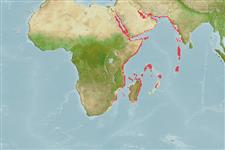Common names from other countries
>
Gobiiformes (Gobies) >
Gobiidae (Gobies) > Gobiinae
Etymology: Eviota: No etymology given, suggested by Christopher Scharpt: from Latin 'eu' for 'true' and 'iota' for anything very small, in combination 'truly very small' referring to it as being the smallest vertebrate at the time it has benn described by Jenkins (thus, making the suggestion by Scharpt plausible..
More on authors: Lachner & Karnella.
Environment: milieu / climate zone / depth range / distribution range
Ecología
marino asociado a arrecife; rango de profundidad 1 - 15 m (Ref. 48637). Tropical
Indian Ocean: Red Sea, Gulf of Aqaba, Gulf of Oman, Seychelles, and Maldives. Records from the Pacific Ocean are most likely E. cf. teresae (except Fiji with E. teresae).
Tamaño / Peso / Age
Maturity: Lm ? range ? - ? cm
Max length : 3.2 cm TL macho / no sexado; (Ref. 11344)
Espinas dorsales (total): 6 - 7; Radios blandos dorsales (total): 8-9; Espinas anales 1; Radios blandos anales: 8 - 9. This species is similar to Eviota albolineata in having similar counts or measurements. Color differences in live and preserved materials are distinct, however, with E. guttata having a dark spot on the ventral side of the head on the isthmus, about in line with the posterior portion of the maxilla and presence of a few scattered melanophores on the underside of the lower jaw near the tip, the intensity of the dark pigmentation varies, from a few melanophores to a very dark area (absent in E. albolineata) (Ref. 83982). Dorsal to anal fin-ray formula 9/8 (Ref. 116739).
Inhabits shallow reefs with mixed algae and coral growth to about 15 meters depth (Ref. 48637). Occurs in coastal and insular areas.
Life cycle and mating behavior
Madurez | Reproducción | Puesta | Huevos | Fecundidad | Larva
Lachner, E.A. and S.J. Karnella, 1978. Fishes of the genus Eviota of the Red Sea with descriptions of three new species (Teleostei: Gobiidae). Smithson. Contrib. Zool. 286:23 p. (Ref. 11636)
IUCN Red List Status (Ref. 130435)
CITES (Ref. 128078)
Not Evaluated
Threat to humans
Harmless
Human uses
Más información
ReferenciasAcuiculturaPerfil de acuiculturaRazasGenéticaElectrophoresesheritabilidadEnfermedadesProcesamientoMass conversion
Herramientas
Special reports
Download XML
Fuentes de Internet
Estimates based on models
Preferred temperature (Ref.
115969): 24.7 - 29.3, mean 28.3 (based on 3568 cells).
Phylogenetic diversity index (Ref.
82804): PD
50 = 0.5000 [Uniqueness, from 0.5 = low to 2.0 = high].
Bayesian length-weight: a=0.00708 (0.00333 - 0.01504), b=3.09 (2.92 - 3.26), in cm Total Length, based on LWR estimates for this (Sub)family-body shape (Ref.
93245).
Nivel trófico (Ref.
69278): 3.1 ±0.3 se; based on size and trophs of closest relatives
Resiliencia (Ref.
120179): Alto, población duplicada en un tiempo mínimo inferior a 15 meses (Preliminary K or Fecundity.).
Fishing Vulnerability (Ref.
59153): Low vulnerability (10 of 100).
